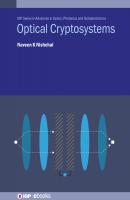Optical Cryptosystems. Naveen K. Nishchal
Чтение книги онлайн.

Читать онлайн книгу Optical Cryptosystems - Naveen K. Nishchal страница 4
Название: Optical Cryptosystems
Автор: Naveen K. Nishchal
Издательство: Ingram
Жанр: Отраслевые издания
isbn: 9780750322201
isbn:
No cryptographic technique can be considered very strong and useful unless cryptanalysis is carried out. There are several types of attacks reported in literature, which have been stated in terms of optical technologies in chapter 11. The optical technologies differ with digital counterparts, whereby in optical schemes either physical keys are used or keys are designed considering physical parameters as compared to digital keys used in electronic systems. There are various types of keys implemented in optical methods, which are discussed in chapter 12.
In all the chapters, the basic principles have been explained with examples. In some of the chapters, numerical simulation results have been provided for better understanding of the subject. Considering the requirement on some of the relevant topics, MATLAB codes have been provided. At the end of each chapter, a list of relevant literature has been provided.
The book is open to comments, criticisms, and suggestions from the readers in improving the quality of the book for future editions.
Acknowledgement
First of all, I would like to thank my mentors at the Indian Institute of Technology (IIT) Delhi during my doctoral studies. I especially thank my PhD supervisors, Professor Kehar Singh and Professor Joby Joseph, for introducing me to the exciting world of optical information processing research. Over the years they have been much more than just a thesis advisor to me. I am sure that they will be happy to see this book out in print. I must thank Dr G Unnikrishnan from IRDE Dehradun with whom I have had numerous discussions. I wish to extend my sincere thanks to Dr A K Gupta, Ex-Director IRDE Dehradun and Professor R S Sirohi, Ex-Director, IIT Delhi, for their encouragement.
My colleagues at IIT Patna deserve due acknowledgments for their encouragement. I acknowledge my gratitude to IIT Patna for providing facilities and a congenial environment. I must thank my colleagues from abroad, Professor Bahram Javidi, University of Connecticut; Professor John T Sheridan, University College Dublin; Professor Thomas J Naughton, Maynooth University; Professor Ayman AlFalou, ISEN/Yncrea; Professor Christian Brosseau, Universite Britagne Occidentale; Professor Cornelia Denz, Universitat Muenster; Professor Yan Zhang, Capital Normal University; Professor Takanori Nomura, Wakayama University; Professor Osamu Matoba, Kobe University; Professor Guohai Situ, Shanghai Institute of Optics and Fine Mechanics; and Professor Xiang Peng, Shenzhen University with whom I have had the opportunity to interact and learn the subject.
I must thank Elsevier, OSA, and SPIE for allowing me to reuse some of their diagrams/images published in various journals. Thanks are due to Jessica Fricchione, Poppy Emerson, and Sarah Armstrong from IOP Publishing, UK, for guiding me on many issues while preparing the manuscript.
I wish to extend my sincere thanks to all my students, Dr Sudheesh K Rajput, Dr Isha Mehra, Dr Dhirendra Kumar, Dr Areeba Fatima, Alok K Gupta, Avishek Kumar, Praveen Kumar, and Yatish. My continuous interactions with them have led me to a deeper understanding of the subject. They helped me in preparing this manuscript and drawing some of the difficult diagrams.
Finally, I owe a lot to my family—particularly to my wife Rinki and my son Anvit for allowing me to spend long hours in preparing this manuscript and for their support throughout. I also thank my other family members in appreciation of their patience, encouragement, and constant support while this manuscript was being prepared.
Author biography
Naveen Kumar Nishchal
Dr Naveen Kumar Nishchal is an associate professor in the Department of Physics at the Indian Institute of Technology (IIT) Patna. He joined IIT Patna in December 2008. Dr Nishchal received his PhD degree in physics from IIT Delhi in 2005. He joined Instruments Research and Development Establishment, Dehradun, under Defence Research and Development Organisation, as a Scientist ‘C’ in July 2004 and worked until June 2007. Subsequently, he moved to IIT Guwahati and worked as an assistant professor in the Department of Physics from June 2007 to November 2008. He has been a visiting researcher to the Oulu Southern Institute, University of Oulu, Finland. His research interests include optical information processing, image encryption, watermarking, digital holography, interferometry, correlation-based optical pattern recognition, and fractional Fourier transform-based signal processing. Dr Nishchal is a senior member of OSA, SPIE, and life member of the Optical Society of India. He is a life member of Indian Science Congress Association, and Lasers and Spectroscopy Society of India. He has authored or co-authored 60 peer-reviewed international journal papers, two book chapters, and 150 papers in various conferences/seminars/symposia.
List of acronyms
| AES | Advanced encryption standard |
| AT | Amplitude-truncated |
| BE | Beam expander |
| BR | Bacteriorhodopsin film |
| BS | Beam splitter |
| CC | Cross-correlation |
| CCA | Chosen-ciphertext attack |
| CCD | Charge-coupled device camera |
| CGH | Computer generated hologram |
| CMOS | Complementary metal-oxide semiconductor |
| COA | Ciphertext-only attack |
| CPA | Chosen-plaintext attack |
| CS | Compressive sensing |
| CT | Computed tomography |
| 1D | One-dimensional |
| 2D | Two-dimensional |
| 3D | Three-dimensional |
| DCT | Discrete cosine transform |
| DES | Data encryption standard |
| DH | Digital holography |
| DOE | Diffractive optical element |
| DRPE | Double random phase encoding |
| DWT | Discrete wavelet transform |
| EFJPS | Encrypted fractional joint power spectrum |
| EMD | Equal modulus decomposition |
| ERA | СКАЧАТЬ